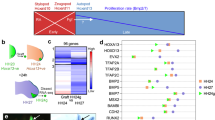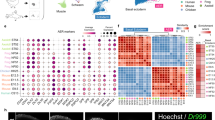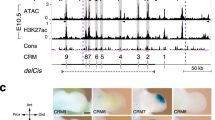Abstract
All-trans-retinoic acid (RA) induces striking digit pattern duplications when locally applied to the developing chick limb bud1–4. Instead of the normal digit pattern (234) a mirror-symmetrical 432234 pattern can be specified. Hence, RA closely mimics posterior limb bud tissue (the zone of polarizing activity, ZPA) that causes very similar duplications when grafted to an anterior site of a host limb bud5. This resemblance raises an intriguing possibility: that RA is related to the as yet unidentified inducer substance thought to be released by the ZPA1,6. Here we report that chick limb buds contain endogenous RA and we show that RA, but not its biosynthetic precursor retinol, forms a concentration gradient across the limb anlage with a high-point in the posterior domain of the limb bud, the part that also contains the ZPA.
This is a preview of subscription content, access via your institution
Access options
Subscribe to this journal
Receive 51 print issues and online access
$199.00 per year
only $3.90 per issue
Buy this article
- Purchase on Springer Link
- Instant access to full article PDF
Prices may be subject to local taxes which are calculated during checkout
Similar content being viewed by others
References
1. Tickle, C, Alberts, B. M., Lee, J. & Wolpert, L. Nature 296, 564–565 (1982). 2. Summerbell, D. / Embryol. exp. Morph. 78, 269–289 (1983). 3. Tickle, C., Lee, J. & Eichele, G. Devl Biol. 109, 82–95 (1985). 4. Eichele, G. Bioscience 36, 534–540 (1986). 5. Saunders, J. W. & Gasseling, M. T. in Epithelial–Mesenchymal Interactions (eds Fleischmajer, R. & Billingham, R. E.) 78–97 (Williams and Wilkins, Baltimore, 1968). 6. Tickle, C., Summerbell, D. & Wolpert, L. Nature 254, 199–202 (1975). 7. Hamburger, V. & Hamilton, H. L. J. Morph. 88, 49–92 (1951). 8. Summerbell, D. /. Embryol. exp. Morph. 32, 227–237 (1974). 9. Frolik, C. A. & Olson, J. A. in The Retinoids Vol. 1 (eds Sporn, M. B., Roberts, A. B. & Goodman, D. S.) 181–233 (Academic, Orlando, 1984). 10. Lin, R. L., Waller, G. R., Mitchell, E. D., Yang, K. S. & Nelson, E. C. Analyt. Biochem. 35,435–441 (1970). 11. Eichele, G., Tickle, C. & Alberts, B. M. J. Cell Biol. 101, 1913–1920 (1985). 12. Eichele, G. & Thaller, C. J. Cell Biol. (submitted). 13. Honig, L. S. & Summerbell, D. J. Embryol. exp. Morph. 87, 163–174 (1985). 14. Hinchliffe, J. R. & Sansom, A. J. Embryol. exp. Morph. 86, 169–175 (1985). 15. Labarca, C. & Paigen, K. Analyt. Biochem. 102, 344–352 (1980). 16. Riezman, H. et al. EMBO J. 2, 1105–1111 (1983). 17. Skipsky, V. & Barclay, M. Meth. Enzym. 14, 530–589 (1969). 18. Tickle, C. Nature 289, 295–298 (1981). 19. Smith, J. C. /. Embryol. exp. Morph. 60, 321–328 (1980). 20. Niazi, I. A. & Saxena, S. Folia biol., Krakow 26, 3–8 (1978). 21. Maden, M. Nature 295, 672–675 (1982). 22. Maden, M. Devl Biol. 98, 409–416 (1983). 23. Thorns, S. D. & Stocum, D. L. Devl Biol. 103, 319–328 (1984). 24. Ito, Y. L., Zile, M., Ahrens, H. & DeLuca, H. F. J. Lipid. Res. 15, 517–523 (1974). 25. Frolik, C. A., Dart, L. L. & Sporn, M. B. Biochim. biophys. Acta 663, 329–335 (1981). 26. Williams, J. B. & Napoli, J. L. Proc. natn. Acad. Sci. U.S.A. 82, 4658–4662 (1985). 27. Wolpert, L. /. theor. Biol. 25, 1–47 (1969). 28. Child, C. M. Arch. Entw. Mech. Org. 35, 598–641 (1913). 29. Meinhardt, H. Models of Biological Pattern Formation (Academic, London, 1982). 30. Crick, F. H. C. Nature 225, 420–422 (1970).
Author information
Authors and Affiliations
Rights and permissions
About this article
Cite this article
Thaller, C., Eichele, G. Identification and spatial distribution of retinoids in the developing chick limb bud. Nature 327, 625–628 (1987). https://doi.org/10.1038/327625a0
Received:
Accepted:
Issue Date:
DOI: https://doi.org/10.1038/327625a0
This article is cited by
-
Highlighting the gaps in hazard and risk assessment of unregulated Endocrine Active Substances in surface waters: retinoids as a European case study
Environmental Sciences Europe (2021)
-
Sonic hedgehog-expressing cells in the developing limb measure time by an intrinsic cell cycle clock
Nature Communications (2014)
-
Retinoic acid in development: towards an integrated view
Nature Reviews Genetics (2008)
-
Potentiation of the teratogenic effects induced by coadministration of retinoic acid or phytanic acid/phytol with synthetic retinoid receptor ligands
Archives of Toxicology (2004)
-
Vertebrate limb development: from Harrison?s limb disk transplantations to targeted disruption of Hox genes
Anatomy and Embryology (2004)
Comments
By submitting a comment you agree to abide by our Terms and Community Guidelines. If you find something abusive or that does not comply with our terms or guidelines please flag it as inappropriate.



